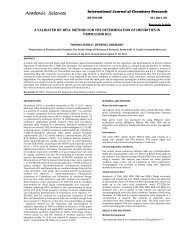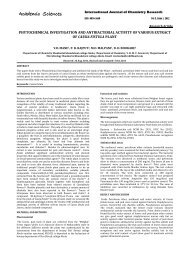edible portion of ridge gourd (luffa acutangula) - international journal ...
edible portion of ridge gourd (luffa acutangula) - international journal ...
edible portion of ridge gourd (luffa acutangula) - international journal ...
- No tags were found...
Create successful ePaper yourself
Turn your PDF publications into a flip-book with our unique Google optimized e-Paper software.
Academic SciencesInternational Journal <strong>of</strong> Chemistry ResearchISSN- 0976-5689 Vol 3, Issue 1, 2012Research ArticlePREPARATIVE HPLC SEPARATION OF SUGARS EXTRACTED FROM NON- EDIBLE PORTION OFRIDGE GOURD (LUFFA ACUTANGULA) AND THEIR IDENTIFICATION BY MASS AND TLCANALYSISR. MYTHILY, C. S. CHIDAN KUMAR $ AND S. CHANDRAJU*Department <strong>of</strong> Studies in Sugar Technology, Sir M. Vishweshwaraya Post-graduate Centre, University <strong>of</strong> Mysore, Tubinakere, Mandya571402, Karnataka, India.$Department <strong>of</strong> Chemistry, G. Madegowda Institute <strong>of</strong> Technology, Bharathi Nagar 571422, India.Email:chandraju1@yahoo.comABSTRACTReceived: 13 Oct 2011, Revised and Accepted: 17 Nov 2011A rapid, sensitive extraction method was developed using the mixture Methanol-Dichloromethane-Water (MDW) (0.3:4:1v/v/v) and MeOH-H 2Ophase was assayed for sugar analysis. Photodiode-array detection (DAD) has been used to prove the extracted compound is UV inactive, Highperformanceliquid chromatography (HPLC) with Evaporative Light Scattering Detector (ELSD) coupled to electrospray ionization massspectrometric (ESI-MS) detection in the positive ion mode gave MS and MSn fragmentation data which were employed for their structuralcharacterization. The various standard sugars were spotted using the solvent system n-butanol - acetone - diethylamine - water (10:10:2:6,v/v/v/v) in the cellulose layer for TLC analysis which indicated the presence <strong>of</strong> lactose, galactose, glucose and xylose. This is the first assay <strong>of</strong> thesugar pr<strong>of</strong>ile <strong>of</strong> the <strong>ridge</strong> <strong>gourd</strong>, which can be further developed for characterization and evaluation <strong>of</strong> their quality with regards to their sugarcomposition.Keyword: Sugar extraction; <strong>ridge</strong> <strong>gourd</strong>; UV inactive; HPLC; ELSD; Separation; LC/MS; TLC.INTRODUCTIONThe Ridge Gourd is an extremely popular vegetable in the African,Asian and the Arabic countries. It is also known by other names suchas lo<strong>of</strong>ah, <strong>luffa</strong>, turai, turiya, tori etc 1 . It is a dark green, <strong>ridge</strong>dvegetable having white pulp with white seeds embedded in spongyflesh. All species <strong>of</strong> <strong>ridge</strong> <strong>gourd</strong>/lo<strong>of</strong>ah are <strong>edible</strong>, but they must beconsumed before they mature, or else they will be too woody andfibrous to eat. It has many health benefits rich in such as dietary,ironand. It is also low in fat and calories 2 . The juice prepared from <strong>ridge</strong><strong>gourd</strong> is a natural remedy for jaundice. Blood purifier because <strong>of</strong> itsblood purifying properties, it helps to purify, restore and nourishliver protecting it from alcohol intoxication 3 . It contains -likepeptides, alkaloids and charantin, which help to lower blood andurine sugar levels without altering blood insulin levels. Cellulose in<strong>ridge</strong> <strong>gourd</strong> helps to overcome constipation and also aids in curingpiles 4 . Inspite <strong>of</strong> all these advantages unlike all vegetables the <strong>ridge</strong><strong>gourd</strong> peels are also thrown as waste. Therefore production <strong>of</strong>various sugars evaluated from the non <strong>edible</strong> <strong>portion</strong> <strong>of</strong> <strong>ridge</strong> <strong>gourd</strong>has considerable promise in the future to achieve economical pr<strong>of</strong>itand moreover utilization <strong>of</strong> the agro-industrial wastes for sugarproduction will be <strong>of</strong> immense benefit at preventing the pollutionalhazards associated with these wastes.MATERIALS AND METHODSExtractionSelected samples are sliced, dried under vacuum at 60 0 C for 48 hrand powdered. 100.0 g <strong>of</strong> raw material was extracted with doublydistilled water 75mL, 15mL <strong>of</strong> 0.1N sulphuric acid and kept underhot plate for about 1 hour at 60°C. Contents are cooled and stirredwell with magnetic stirrer for 30’. Neutralized using AR bariumhydroxide and precipitated barium sulphate is filtered <strong>of</strong>f. Theresulting syrup was stored at 4 ° C in the dark. The syrup was treatedwith charcoal (coir pith) and agitated for 30’ followed by Silica gel(230-400 mesh) packed in a sintered glass crucible for about 2cmthickness connected to suction pump, where rota vapour removedthe solvent <strong>of</strong> the filtrate. The residue was placed in an air tight glasscontainer covered with 200 ml <strong>of</strong> boiling 80% ethanol. Aftersimmering for several hours in a steam bath, the container wassealed and stored at room temperature. For the analysis, sample washomogenized in a blender for 3-5’at high speed and then filteredthrough a Buchner funnel using a vacuum source replicatedextraction with 80% EtOH (2 x 50mL) each time and the wholesyrup was concentrated. Methanol - Dichloromethane - water(0.3:4:1, v/v/v), Sample tubes fed with the mixture were looselycapped, placed in a water bath for 5S, and left at room temperaturefor 10’and placed in separating funnel, agitated vigorously byoccasional release <strong>of</strong> pressure, results two phases. The organicphase was discarded which removes the organic impurities and themethanol: water phase was assayed for sugar. The residues wereoven-dried at 50°C overnight to remove the residual solvent, andstored in refrigerator for analysis 5- 9 .InstrumentationThe mixture was separated in 26’by reversed phase HPLC on anAdsorbosphere column-NH2, (250 x 4.6 mm column) using bothisocratic and gradient elution with acetonitrile/water and detectedusing Waters ELSD 2420. In ELSD, the mobile phase is firstevaporated. Solid particles remaining from the sample are then carriedin the form <strong>of</strong> a mist into a cell where they are detected by a laser. Theseparated fractions were subjected to UV analysis using Agilent 8453coupled with Diode array detector. HPLC–MS analysis was performedwith LCMSD/ Trap System (Agilent Technologies, 1200 Series)equipped with an electrospray interface. The MS spectra wereacquired in positive ion mode. The mobile phase consisted <strong>of</strong> 0.10%formic acid in hplc grade deionized water (A) (milli-q-water (subjectedto IR radiation under 3.5 micron filters) and Methanol (B) taken in thestationary phase <strong>of</strong> Atlantis dc 18 column (50 x 4.6mm - 5µm). Thegradient program was as follows: 10% B to 95% B in 4 min, 95% B to95% B in 1 min, 95% B to 10% B in 0.5 min followed by 10% B in 1.5min at a flow rate <strong>of</strong> 1.2 mL min -1 . The column oven temperature waskept at 40°C and the injection volume was 2.0 µL. Product massspectra were recorded in the range <strong>of</strong> m/z 150-1000. Theinstrumental parameters were optimized before the run.Preparation <strong>of</strong> chromatoplatesThin layer chromatography was performed for the concentratedseparated fraction using Cellulose MN 300 G. The fractions obtainedwere subjected to one dimensional chromatogram on a celluloselayer plate. Each plate was activated at 110°C prior to use for 10’.Standard samplesPure samples D (-) Arabinose, D (-) Ribose, D (+) Xylose, D (+)Galactose, D(+) Glucose, D (+) Mannose, L (-) Sorbose, D (-) Fructose,L (+) Rhamnose, D (+) Sucrose and D (+) Maltose, D (+) Lactose wereused as standard.
Chandraju et al.Int J Chem Res, Vol 3, Issue 1, 2012, 40-44One – dimensional chromatography10 mg <strong>of</strong> each sugar and the separated fractions were dissolved in1ml <strong>of</strong> deionised water. 1µL <strong>of</strong> each sugar solution was applied tothe chromatoplate with the micropipette in the usual manner. Thechromatoplate was placed in the chamber containing the developingsolvent. The solvent system used was n-butanol - acetone -diethylamine - water (10:10:2:6 v/v/v/v). The plates weredeveloped in an almost vertical position at room temperature,covered with lid 10-14 . After the elution, plate was dried under warmair. The plate was sprayed with 5% diphenylamine in ethanol, 4%aniline in ethanol and 85% phosphoric acid (5:5:1v/v/v). The platewas heated for 10’at 105°C. While drying coloured spots appear. TheR f values relative to the solvent are reported below.RESULTS AND DISCUSSIONAnalysis report showed that the extracted separated componentsare UV inactive shown in Fig. 1, and their respective retention timefalls as follows 0.662, 0.658, 0.641, and 0.675 shown in Fig. 2.Fig. 1: UV inactive spectrum <strong>of</strong> the Separated FractionsFig. 2: Retention Time <strong>of</strong> the four Separated Fractions41
Chandraju et al.Int J Chem Res, Vol 3, Issue 1, 2012, 40-44The Mass Spectrum detector gave the following spectrum <strong>of</strong>fraction1 at 0.578 min, fraction2 at 0.525 and 0.702min,fraction3 at 0.606 and 2.637min, fraction4 at 0.595 and2.576min. The MS report recorded at the appropriate time as perMSD for Fraction1 scanned between the time period 0.493:0.772gave m/z values 112.9, 145.1, 163.0, 164.1, 180.1, 202.9.Fraction2 scanned between the time periods 0.480: 0.546 mingave m/z values 115.1, 145.1, 175.9, 279.2, 312.1, 366.0, 365.0,707.2 and 0.573: 0.812 min gave m/z values 111.2, 145.1, 279.2,312.1, 360.0, 365.0, 707.2. Fraction3 scanned between the timeperiod 0.507: 0.798 min and 2.495: 2.760min gave m/z values112.9, 145.1, 163.0, 180.1, 198.0, 360.0 and 112.1. Fraction4scanned between the time period 0.520 : 0.745 and 2.508 : 2.667gave m/z values 111.2, 145.1, 150.1, 272.9, 305.1, 326.1, 327.1,331.0 and 112.2, 145.1, 278.9, 312.1 respectively which gives aconclusion that these masses corresponds to Hexose, pentoseand disaccharides whose masses are 180.1, 150.1 and 360.0respectively depicted in Fig. 3-6.Fig. 3: Mass report <strong>of</strong> Separated Fraction 1Fig. 4: Mass report <strong>of</strong> Separated Fraction 242
Chandraju et al.Int J Chem Res, Vol 3, Issue 1, 2012, 40-44Fig. 5: Mass report <strong>of</strong> Separated Fraction 3Fig. 6: Mass report <strong>of</strong> Separated Fraction 443
Chandraju et al.Int J Chem Res, Vol 3, Issue 1, 2012, 40-44Thin layer chromatographic analysis reportFour separated and purified sample fractions are spotted in thecellulose layer and the eluted species were mentioned as F 1, F 2, F3, F 4 in the chromatogram shown in Fig. 7.The fractions obtained were found to be matching with the standardsugars identified as Lactose, galactose, glucose and xylose. Rf valuefor the analytical grade samples which also shows the matchingfractions Table 1.Fig. 7: Developed thin layer chromatogram over a cellulose layer, (La – Lactose, So – Sorbose, Ar- Arabinose, Rh – Rhamnose, Ri – Ribose,Xy-Xylose, Gal – Galactose, Gl - Glucose, Man – Mannose, Fr - Fructose, Su – Sucrose and Mal –Maltose).Table 1: R f values matching <strong>of</strong> the analytical standard samples and the separated samplesSugarsR f ( Scale <strong>of</strong> R f =1)Fraction matchingLactose 0.18 F1Maltose 0.24 -Sucrose 0.35 -Galactose 0.36 F2Glucose 0.41 F3Mannose 0.47 -Sorbose 0.46 -Fructose 0.46 -Arabinose 0.46 -Xylose 0.53 F4Ribose 0.63 -Rhamnose 0.70 -CONCLUSIONThe quantity <strong>of</strong> the discarded <strong>portion</strong> is very high; therefore,because <strong>of</strong> disposal problems the household solid wastes are <strong>of</strong>greater importance. A fruitful and economic industrial applicationwas applied in this current work. Based on the above studies, a rapidmethod for the extraction <strong>of</strong> water soluble sugar has beendeveloped. The mixture MDW gives better results as compared withMCW, i.e dichloromethane was replaced instead <strong>of</strong> chlor<strong>of</strong>orm 15 .HPLC has proven to be more selective than conventional wetmethods; Mass and TLC analysis gives accurate confirmation for thepresence <strong>of</strong> lactose, galactose, glucose and xylose.REFERENCES1. Ho Pham-Hoang. An Illustrated Flora <strong>of</strong> Vietnam. 1991; 1(2):718 - 727.2. Jansen GJ, Gildemacher BH , Phuphathanaphong L, Luffa P, Miller.Plant Resources <strong>of</strong> South-East Asia, Vegetables 1993; 194 - 197.3. Xie Zongwa, Yu Youqin, (Editors). Materia Medica, ChineseTerminology 1996; 1.4. Bois D. Encyclopédie Biologique, Les Plantes Alimentaires,Ed.Paul Lechevalier. 1927;5. Chandraju S, Mythily R, Chidan Kumar CS. J Chem Pharm Res2011; 3(3): 312-321.6. Chandraju S, Mythily R, Chidan Kumar CS. J Chem Pharm Res2011; 3(4): 422-429.7. Chandraju S, Mythily R, Chidan Kumar CS. Int J Cur Sci Res2011; 1: 125-128.8. Chandraju S, Mythily R, Chidan Kumar CS. Asian. J. Chem, 2012,24(5), 2170-2172.9. Chandraju S, Mythily R, Chidan Kumar CS. Recent Research inScience and Technology 2011; 3: 58-62.10. Sharaf A, Ola, Sharaf A, Hegazi SM, Sedky K. Chemical andbiological studies on banana fruit, Cairo University 1979; 18: 8-15.11. Baldwin E, Bell DJ. Cole's Practical Physiological Chemistry1955; 189.12. Schweiger A. Journal <strong>of</strong> Chromatography 1962; 9: 374.13. Vomhot DW, Tucher TC. Journal <strong>of</strong> Chromatography 1963;17:300.14. Lato M, Brunelli B Ciuffins G. Journal <strong>of</strong> Chromatography 1968;34:26.15. Pak S, Chow, Simon M, Landhäusser. Tree Physiology 2004;24:1129 –1136.44














